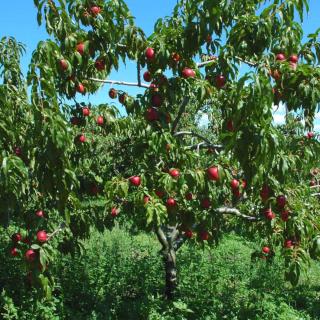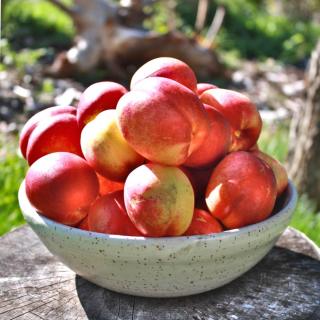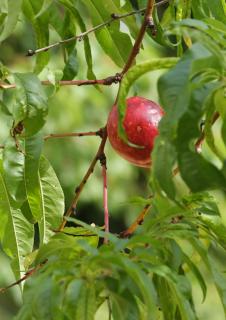

The nectarine tree belongs to the same family as the peach tree, but without fuzz.
A summary of nectarine tree facts
Name – Prunus Persica nucipersica
Family – Rosaceae
Type – fruit tree
Height – 6 ½ to 16 feet (2 to 5 meters)
Climate – temperate and warm
Exposure – full sun
Soil: ordinary, well drained – Foliage: deciduous – Harvest: summer
It is an exceptional fruit tree that calls for special care before harvesting. Planting, pruning and treating is important to avoid diseases for your nectarine tree.
Our recommendation is to plant your nectarine tree in a sunlit and wind-sheltered spot so that dominant winds don’t sweep through.
Once the spot is chosen, plant your nectarine tree in fall or in spring.
The nectarine tree is more hardy than one thinks, since it can resist temperatures as cold as 5° to -4°F (-15 to -20°C).

Every year, it is important to prune your tree at the end of winter just above a well-formed wood bud.
It is important to perform a fruit-inducing pruning to trigger appearance of many beautiful nectarines.
You can also treat your nectarine tree before the first leaves appear, with organic acaricide (mite killer) or a spray containing Bordeaux mixture.

With an early cute pink blooming, your nectarine tree will produce magnificent fruits for you during the summer.
The difference between peach and nectarine is mostly on appearance since the peach tree bears a velvety skin whereas the nectarine’s skin is smooth. The nectarine is smooth and shiny.

Read more about helpful orchard management:
Learn to use organic products, because nowadays they have become very effective and won’t contaminate the fruits you’re eating…
I’ve had a nectarine planted for 7 years. In the past few years the Curly leaf was ever present. This year I decided to spray the plant before the first buds. Now the tree looks like it’s dying, it has few leaves, and the few “new branches” break off . We had a drought winter, but the tree did get water. Now, I am watering it everyday and have given in spike plant food. Is there anything I can do to save the tree?
Hi Cindy, it’s always frustrating when a cure turns out to weaken the tree instead of fortifying it. Perhaps the spray was a bit too aggressive? It seems to me that the tree might have been poisoned. Here’s a few tips on how to try to save a poisoned tree. Perhaps there are a few things that might help.
There’s a small chance that having sprayed just before a freeze damaged buds and leaves. Wet buds tend to freeze and die when temperatures drop early morning. If you think this might have happened, then the tree should recover in time.